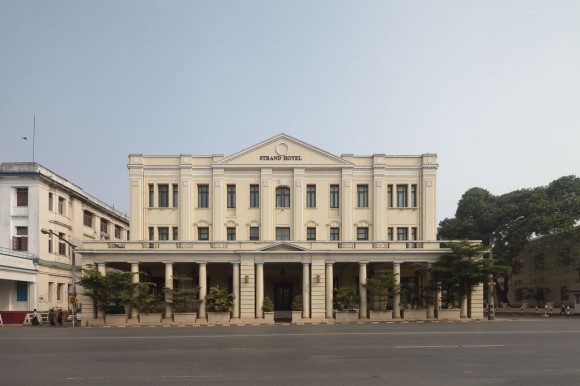This blog has allowed me to structure my explorations of the past one and a half years. One particular project originated from these and is now taking up more and more of my time: My friend and photographer Manuel Oka and I are currently working on an architectural guide to Yangon.
Update 20 May 2014: My close friend Elliott Fox has agreed to come onboard to help write and edit the book. Elliott has travelled to Myanmar on numerous occasions both professionally and personally.
Strand Hotel – photo by Manuel Oka
The book will be published in 2015. In it, we will feature about 100 buildings from all periods – pre-colonial, colonial, post-independence and present. The split we anticipate is about 40-50 buildings from the colonial era, 25 religious edifices and 25 post-independence/contemporary structures. On top of that, we will explore the architecture and recent history of Myanmar’s new capital Naypyidaw, inextricably interconnected with Yangon’s architectural developments.
For each building, we are going to feature 1-4 of Manuel’s fabulous photos that he has taken during two long-term stints in Yangon over the last year. 200-600 words per building will highlight the main facts (year built, architect, location, architectural details, materials, etc.). We anticipate that this will bring the total number of pages to about 250-300.
In terms of editorial direction, the book is going to appeal to architects and non-architects alike. The latter group is also going to include the growing number of tourists and business travelers that flock to the newly-opened country. The buildings will serve as a departure point for various anecdotes with which we will bring back to life aspects of Myanmar’s past, present and future.
The Inya Lake Hotel (above), for example, will allow us to recount the changing relationship between Burma and the Soviet Union, as the building was a present given by former General Secretary of the Communist Party of the Soviet Union Nikita Khrushchev during a state visit in the 1950s. The Burma Oil Company HQ, a beautiful colonial-era building, can be the link to the veritable rush of oil exploration currently taking place in Burma’s offshore waters.
We are currently finalizing the shortlist of our buildings and are going through the material we were able to research on the ground. In Yangon, we rely on some local hands to help us with the remaining fact-finding, and have made some great contacts in that regard. Our work mode is totally reliant on Dropbox, Google Maps, Google Docs, etc., making this also a great experiment in remote collaboration.
I’ll keep this space updated regarding the book.



